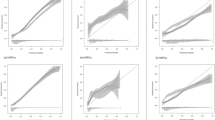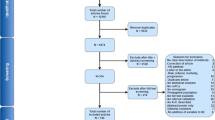Abstract
Purpose
To develop a novel Taiwanese prostate cancer (PCa) risk model for predicting PCa, comparing its predictive performance with that of two well-established PCa risk calculator apps.
Methods
1545 men undergoing prostate biopsies in a Taiwanese tertiary medical center between 2012 and 2019 were identified retrospectively. A five-fold cross-validated logistic regression risk model was created to calculate the probabilities of PCa and high-grade PCa (Gleason score ≧ 7), to compare those of the Rotterdam and Coral apps. Discrimination was analyzed using the area under the receiver operator characteristic curve (AUC). Calibration was graphically evaluated with the goodness-of-fit test. Decision-curve analysis was performed for clinical utility. At different risk thresholds to biopsy, the proportion of biopsies saved versus low- and high-grade PCa missed were presented.
Results
Overall, 278/1309 (21.2%) patients were diagnosed with PCa, and 181 out of 278 (65.1%) patients had high-grade PCa. Both our model and the Rotterdam app demonstrated better discriminative ability than the Coral app for detection of PCa (AUC: 0.795 vs 0.792 vs 0.697, DeLong’s method: P < 0.001) and high-grade PCa (AUC: 0.869 vs 0.873 vs 0.767, P < 0.001). Using a ≥ 10% risk threshold for high-grade PCa to biopsy, our model could save 67.2% of total biopsies; among these saved biopsies, only 3.4% high-grade PCa would be missed.
Conclusion
Our new logistic regression model, similar to the Rotterdam app, outperformed the Coral app in the prediction of PCa and high-grade PCa. Additionally, our model could save unnecessary biopsies and avoid missing clinically significant PCa in the Taiwanese population.

Similar content being viewed by others
Data availability
All data were retrospectively recorded via electronic medical records, merely by I-Hsuan Alan Chen. Following data collection, they were anonymized and then analyzed. The other authors could not get access to the identity of research participants.
References
Research2Guidance. mHealth App Economics: current statuts and future trends in mobile health (2017). https://research2guidance.com/product/mhealth-economics-2017-current-status-and-future-trends-in-mobile-health/. Accessed 30 July 2019
World Health Organization. eHealth at WHO (2016). https://www.who.int/ehealth/about/en/. Accessed 30 July 2019
Statista Research Department. Number of smartphone users in Taiwan from 2015 to 2020 (in millions) https://www.statista.com/statistics/755288/taiwan-number-of-smartphone-users/. Accessed 16 Dec 2016
Bray F, Ferlay J, Soerjomataram I, Siegel RL, Torre LA, Jemal A (2018) Global cancer statistics 2018: GLOBOCAN estimates of incidence and mortality worldwide for 36 cancers in 185 countries. CA Cancer J Clin 68(6):394–424
Ferlay J EM, Lam F, Colombet M, Mery L, Pineros M, Znaor A, et al. Global cancer observatory: cancer today. Lyon, France: International Agency for Research on Cancer. 2018. https://gco.iarc.fr/today. Accessed 28 July 2019
Health Promotion Administration. Taiwan Cancer Registry Annual Report, 2016 2018. https://www.hpa.gov.tw/Pages/TopicList.aspx?nodeid=269&idx=0. Accessed 28 July 2019
Chiang CJ, Lo WC, Yang YW, You SL, Chen CJ, Lai MS (2016) Incidence and survival of adult cancer patients in Taiwan, 2002–2012. J Formos Med Assoc 115(12):1076–1088
Wolf AM, Wender RC, Etzioni RB, Thompson IM, D'Amico AV, Volk RJ et al (2010) American Cancer Society guideline for the early detection of prostate cancer: update 2010. CA Cancer J Clin 60(2):70–98
Poyet C, Nieboer D, Bhindi B, Kulkarni GS, Wiederkehr C, Wettstein MS et al (2016) Prostate cancer risk prediction using the novel versions of the European Randomised Study for Screening of Prostate Cancer (ERSPC) and Prostate Cancer Prevention Trial (PCPT) risk calculators: independent validation and comparison in a contemporary European cohort. BJU Int 117(3):401–408
Roobol MJ, Verbeek JFM, van der Kwast T, Kummerlin IP, Kweldam CF, van Leenders G (2017) Improving the Rotterdam European Randomized Study of Screening for Prostate Cancer Risk Calculator for Initial Prostate Biopsy by Incorporating the 2014 International Society of Urological Pathology Gleason Grading and Cribriform growth. Eur Urol 72(1):45–51
Ankerst DP, Hoefler J, Bock S, Goodman PJ, Vickers A, Hernandez J et al (2014) Prostate Cancer Prevention Trial risk calculator 2.0 for the prediction of low- vs high-grade prostate cancer. Urology 83(6):1362–1367
Louie KS, Seigneurin A, Cathcart P, Sasieni P (2015) Do prostate cancer risk models improve the predictive accuracy of PSA screening? A meta-analysis Ann Oncol 26(5):848–864
He BM, Chen R, Sun TQ, Yang Y, Zhang CL, Ren SC et al (2019) Prostate cancer risk prediction models in Eastern Asian populations: current status, racial difference, and future directions. Asian J Androl 22:158
Weinreb JC, Barentsz JO, Choyke PL, Cornud F, Haider MA, Macura KJ et al (2016) PI-RADS prostate imaging—reporting and data system: 2015, Version 2. Eur Urol 69(1):16–40
Steyerberg EW, Vickers AJ, Cook NR, Gerds T, Gonen M, Obuchowski N et al (2010) Assessing the performance of prediction models: a framework for traditional and novel measures. Epidemiology 21(1):128–138
DeLong ER, DeLong DM, Clarke-Pearson DL (1988) Comparing the areas under two or more correlated receiver operating characteristic curves: a nonparametric approach. Biometrics 44(3):837–845
Van Calster B, Wynants L, Verbeek JFM, Verbakel JY, Christodoulou E, Vickers AJ et al (2018) Reporting and interpreting decision curve analysis: a guide for investigators. Eur Urol 74(6):796–804
Karakiewicz PI, Benayoun S, Kattan MW, Perrotte P, Valiquette L, Scardino PT et al (2005) Development and validation of a nomogram predicting the outcome of prostate biopsy based on patient age, digital rectal examination and serum prostate specific antigen. J Urol 173(6):1930–1934
Chun FK, Briganti A, Graefen M, Montorsi F, Porter C, Scattoni V et al (2007) Development and external validation of an extended 10-core biopsy nomogram. Eur Urol 52(2):436–444
Kawakami S, Numao N, Okubo Y, Koga F, Yamamoto S, Saito K et al (2008) Development, validation, and head-to-head comparison of logistic regression-based nomograms and artificial neural network models predicting prostate cancer on initial extended biopsy. Eur Urol 54(3):601–611
De Nunzio C, Lombardo R, Tema G, Cancrini F, Russo GI, Chacon R et al (2019) Mobile phone apps for the prediction of prostate cancer: external validation of the Coral and Rotterdam apps. Eur J Surg Oncol 45(3):471–476
Chiu PK, Roobol MJ, Nieboer D, Teoh JY, Yuen SK, Hou SM et al (2017) Adaptation and external validation of the European randomised study of screening for prostate cancer risk calculator for the Chinese population. Prostate Cancer Prostatic Dis 20(1):99–104
Alberts AR, Roobol MJ, Verbeek JFM, Schoots IG, Chiu PK, Osses DF et al (2019) Prediction of high-grade prostate cancer following multiparametric magnetic resonance imaging: improving the rotterdam european randomized study of screening for prostate cancer risk calculators. Eur Urol 75(2):310–318
Roobol MJ, Vedder MM, Nieboer D, Houlgatte A, Vincendeau S, Lazzeri M et al (2015) Comparison of two prostate cancer risk calculators that include the prostate health index. Eur Urol Focus 1(2):185–190
Author information
Authors and Affiliations
Contributions
IAC: project development, data collection, manuscript writing; CC: data analysis; JL: manuscript editing; JT: manuscript editing; CY: manuscript editing; ANS: manuscript editing; MC: project development, manuscript editing; PS: project development, manuscript editing.
Corresponding author
Ethics declarations
Conflict of interest
The authors declared no potential conflicts of interest.
Ethical approval
Our study was performed in accordance with the principles of the 1964 Declaration of Helsinki. Ethics approval was granted by the Internal Review Board of a Taiwanese tertiary medical center (IRB No.: VGHKS19-CT3-13).
Informed consent
Owing to the retrospective nature of our study, the informed consent was waived.
Additional information
Publisher's Note
Springer Nature remains neutral with regard to jurisdictional claims in published maps and institutional affiliations.
Electronic supplementary material
Below is the link to the electronic supplementary material.
Rights and permissions
About this article
Cite this article
Chen, I.H.A., Chu, CH., Lin, JT. et al. Comparing a new risk prediction model with prostate cancer risk calculator apps in a Taiwanese population. World J Urol 39, 797–802 (2021). https://doi.org/10.1007/s00345-020-03256-2
Received:
Accepted:
Published:
Issue Date:
DOI: https://doi.org/10.1007/s00345-020-03256-2




